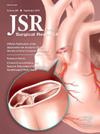Is Recognition in Transplant Surgery Equitable? A Two-decade Analysis of Transplant Award Recipients
IF 1.8
3区 医学
Q2 SURGERY
引用次数: 0
Abstract
Introduction
Awards from medical societies aim to recognize contributions and support academic growth. However, women and individuals from marginalized backgrounds are often underrepresented. This analysis examined the demographics of award recipients and award committee members from the American Society of Transplant Surgeons and American Society of Transplantation over 2 decades.
Materials and methods
Six American Society of Transplant Surgeons (ASTS) awards from 1995 to 2023 and 15 The American Society of Transplantation (AST) awards from 2000 to 2023 were assessed. Publicly available databases provided demographic data for recipients and committee members, categorized by race/ethnicity (non-Hispanic White, Black, Asian, and Hispanic) and sex (male and female). Recipients' highest degrees attained, professions, and institution affiliations were also gathered. The NIH's Research Portfolio Online Reporting Tool was used to examine the amount of NIH funding allocated to the recipients' affiliated institutions.
Results
76.8% of recipients were non-Hispanic White, 14.4% Asian, 6.1% Hispanic, and 2.8% Black. The majority of awardees were surgeons at 37%, while 78% held MD credentials. The proportion of female award recipients was increased by 19% for AST and 33% for ASTS over the examined timeframe. No significant shifts were observed in the racial composition of award recipients for both AST and ASTS. More awards were given to individuals affiliated with institutions ranked in the top quartile for NIH funding for both AST and ASTS awards (P = 0.039; P = 0.018).
Conclusions
Among the two transplant surgery societies, recognition of female recipients has significantly increased. However, equitable recognition of individuals from underrepresented backgrounds remains insufficient. Further progress is needed to acknowledge the contributions of those from diverse backgrounds and professions.
求助全文
约1分钟内获得全文
求助全文
来源期刊
CiteScore
3.90
自引率
4.50%
发文量
627
审稿时长
138 days
期刊介绍:
The Journal of Surgical Research: Clinical and Laboratory Investigation publishes original articles concerned with clinical and laboratory investigations relevant to surgical practice and teaching. The journal emphasizes reports of clinical investigations or fundamental research bearing directly on surgical management that will be of general interest to a broad range of surgeons and surgical researchers. The articles presented need not have been the products of surgeons or of surgical laboratories.
The Journal of Surgical Research also features review articles and special articles relating to educational, research, or social issues of interest to the academic surgical community.

 求助内容:
求助内容: 应助结果提醒方式:
应助结果提醒方式:


